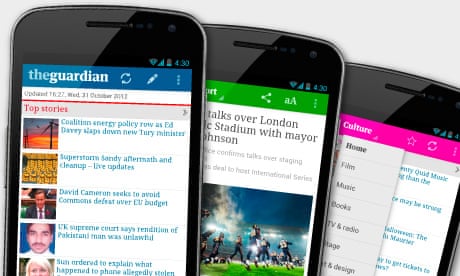As we set about redesigning our mobile site, one question that came up again and again was what the traffic to our existing site looked like.
We'd always known mobile to be a "fragmented" space, with the number of handsets expanding seemingly by the day, but could we get a better picture of what that fragmentation looked like?
A dip into the data proved instructive.
Note: we've looked at the top 250 mobile phone models ranked in terms of pages viewed. We looked at traffic to m.guardian.co.uk, our native iPhone and Android apps, and mobile devices accessing the guardian.co.uk desktop site. We did not include traffic to our iPad edition app.
The first "treemap" below shows overall mobile traffic to the Guardian website broken down by brand of device in October 2010.
The iPhone looms large on the right, taking up well over a third of all traffic in its own right, but the iPad, launched only six months previously, has already nudged comfortably into second place, meaning Apple, even at that stage, was accounting for well over half of all the Guardian's mobile traffic – despite having only three basic types of device (the third rectangle in the Apple area is the iPod Touch).
Contrast this with the then second place-holder, RIM, the BlackBerry maker, and Nokia, who account for 50 types of devices between them.
Fast forward two years (the treemap below) and the full impact of the Apple expansion into mobile becomes clear. The iPad, iPhone, and iPod Touch now account for the best part of three quarters of all Guardian mobile traffic.
Meanwhile, there's been some notable declines. The growth of Samsung is also clear, with 66 devices in our top 250.
The challenge that faced our mobile team – designing a web page that caters to all these different device types – becomes clearer when you consider just how many individual handsets you're dealing with. The bar chart below shows the number of devices made by the different manufacturers that access the Guardian site – again, comparing 2010 with today. Samsung and HTC alone now account for well over 100 devices. Add in Nokia and you're at more than 150. Add in RIM, Sony and LG and you've broken 200.
But these breakdowns mask perhaps the most important trend of all, which is the sheer rise in overall traffic to our site on mobile devices (shown below). Two years ago, mobile traffic was less than a quarter of what it is today. We now serve roughly 3.3 million pages on mobile devices each day, not including our views of our iPad app.
It's a testament to how completely mobile devices have permeated our behaviour: they are now simply "there", a constant presence throughout the day; the compact channel through which we receive the rich information in our world.

Comments (…)
Sign in or create your Guardian account to join the discussion